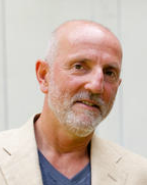Dec 8, 2011 - Lorenzo Pavesi
Joint Meeting with Boston Chapter IEEE Photonics Society http://www.bostonphotonics.org/seminar.asp?seminar=166
Joint Meeting with Boston Chapter IEEE Photonics Society http://www.bostonphotonics.org/seminar.asp?seminar=166
Adaptive optics was first suggested by an astronomer, Horace Babcock, as a means of overcoming the "seeing" in ground-based observing. It is now implemented on all of the world's large optical telescopes and underpins the case for building the next generation of 30-40m diameter telescopes. Much of the first R&D in adaptive optics was carried out by the military, and several companies in the Boston area were prominent in the early days and still are today (Itek, Adaptive Optics Associates, Xinetics, Boston Micromachines, to name a few). Adaptive optics is now used in many other fields of science and engineering, and in at least one consumer product. In this talk, I will review the principles of adaptive optics and give some examples of its successful application in astronomy and vision science. No one knows where the subject is going but I will point out some directions and curiosities which might be developed further, such as optical vortex annihilation and AO in highly scattering media.
 Chris Dainty is currently Professor of Applied Physics at The National University of Ireland, Galway. From 1984 to 2002, he was Pilkington Professor of Applied Optics at Imperial College London, and before that was Associate Professor of Optics at The University of Rochester NY (1978-1983). Prof Dainty has co-authored a number of books, including 'Image Science' (1974) with Rodney Shaw. He has co-authored >170 peer-reviewed papers and supervised 58 PhD students. He is the 1984 recipient of the International Commission of Optics Prize, the 1993 Thomas Young Medal and Prize (IoP), the 2003 C E K Mees Medal and Prize (OSA) and the 2004 Optics and Photonics Division Prize (IoP). He is also a Fellow of The Optical Society of America, SPIE, The Institute of Physics (UK) and The European Optical Society. In March 2008 he was elected a Member of the Royal Irish Academy. Professor Dainty has served as President of the International Commission for Optics (1990-1993) and the European Optical Society (2002-2004) and was the 2011 President of the Optical Society of America.
Chris Dainty is currently Professor of Applied Physics at The National University of Ireland, Galway. From 1984 to 2002, he was Pilkington Professor of Applied Optics at Imperial College London, and before that was Associate Professor of Optics at The University of Rochester NY (1978-1983). Prof Dainty has co-authored a number of books, including 'Image Science' (1974) with Rodney Shaw. He has co-authored >170 peer-reviewed papers and supervised 58 PhD students. He is the 1984 recipient of the International Commission of Optics Prize, the 1993 Thomas Young Medal and Prize (IoP), the 2003 C E K Mees Medal and Prize (OSA) and the 2004 Optics and Photonics Division Prize (IoP). He is also a Fellow of The Optical Society of America, SPIE, The Institute of Physics (UK) and The European Optical Society. In March 2008 he was elected a Member of the Royal Irish Academy. Professor Dainty has served as President of the International Commission for Optics (1990-1993) and the European Optical Society (2002-2004) and was the 2011 President of the Optical Society of America.
Joint Meeting with Boston IEEE Photonics Society
GNitride-based visible light emitting diodes (LEDs) with high external efficiency are widely used for a variety of applications including display backlights and general lighting. The versatility of LED devices can be further enhanced by introducing individually addressable emissive elements on a silicon-based substrate with the use of flip-chip technology. Such passive matrix LED micro-arrays have been demonstrated in the past. However, the array dimensions and pixel brightness in conventional passive addressable LED arrays are limited by the loading effect in the same row or column. Recently, we employed active matrix (AM) addressing scheme to improve the operating effectiveness of LED arrays. LED on Silicon (LEDoS) display panels have great potential on applications such as micro-display in mobile electronics, portable micro-projectors, bio-sensor arrays and programmable lighting sources.
In this work, we report the development of high-resolution LEDoS micro-array display panels (6mm×7mm in size), by integrating an InGaN Multiple Quantum Well (MQW) Ultraviolent (UV) LED micro-array to a AM silicon-based substrate. The LEDoS device included two main parts: LED micro-array and AM substrate. LED micro-array and AM substrate were integrated together using flip-chip technology. When applied proper scan signal and data signal, the LEDoS display panel was programmed row by row and column by column. The LEDoS display panel generates representative micro-display images at a fresh frequency of 200 Hz, demonstrating sufficient driving capability and individually control ability.
Our recent work on high-speed normal-incidence and butt-coupled p-i-n InGaAs photodetectors epitaxially grown on silicon substrates by MOCVD will also be reported.
Optical components are getting smaller and smaller, leading to interesting new medical devices. This talk will touch on the extension of traditional glass grinding & polishing methods, polymer injection molding, semiconductor-type lithography, and other fabrication methods to produce optical elements as small as 200um. Tiny lenses, prisms, diffraction gratings, pixelized polarizers, GRIN components, optical MEMS, and cameras-on-chip are being used to design the world’s smallest endoscopes, implantable optical sensors, spectrometers, and robotic vision systems. The talk will survey some of the latest innovations from a product engineer’s perspective. A few fabricators of these tiny components will be invited to participate in Q&A.

Mr. Chinnock commercializes technologies that use light to diagnose and treat disease. He has been involved with scores of medical devices and laboratory instruments that sense, image, irradiate, or analyze organs, tissues, or body fluids. Recent examples include an ophthalmic instrument for diagnosing dry eye syndrome, a wavefront aberrometer, a disposable endoscope for viewing inside body cavities, an optical scanning system for fitting hearing aids, and a robotic vision system. As CEO of Optimum Technologies, Inc. since its founding in 1994, Mr. Chinnock has worked with companies of all sizes on the development and commercialization of light-based devices. His 30+ years of experience include engineering, manufacturing, marketing, and general management positions at several companies engaged in electro-optical devices and systems, including Varian, United Detector Technologies, Smith & Nephew, and Henke Sass Wolf of America. In addition to its engineering and production services, his company is currently developing its own proprietary retinal imaging technology for screening for diabetic retinopathy under funding from the National Institutes of Health. He holds a BS in Engineering Physics from the University of Colorado and studied Mechanics and Materials Science at Johns Hopkins University.
{slideshare} [slideshare id=9996915&doc=sppsweapnesosaoct2011-111102151358-phpapp02] {/slideshare}
The NASA Solar Probe Plus (SPP) mission will be humanity’s first mission to the Sun. The spacecraft will close to within about four million miles of the solar surface in order to observe the acceleration of the solar wind first hand. A key requirement for Solar Probe Plus is the ability to make continuous, accurate, and fast measurements of the electrons and ionized helium (alpha-particles) and hydrogen (protons) that constitute the bulk of the solar wind. The Solar Wind Electrons Alphas and Protons (SWEAP) Investigation is a two-instrument suite that provides these particle observations. SWEAP consists of the Solar Probe Cup (SPC) and the Solar Probe Analyzers (SPAN). SPC is a Faraday Cup that looks at the Sun and measures ion and electron fluxes and flow angles as a function of energy. SPAN consists of an ion and electron electrostatic analyzer on the ram side of SPP (SPAN-A) and an electron ESA on the anti-ram side (SPAN-B). SPAN-A and -B are rotated 90 degrees relative to one another so their broad FOV combine to view the entire sky. The talk will describe the science motivation for Solar Probe and specifically SWEAP, the instrument designs, and the expected data. SWEAP measurements enable discovery and understanding of solar wind acceleration and formation, coronal and solar wind heating, and high-energy particle acceleration.
Page 2 of 3
PROFESSIONAL SPONSORS |
CORPORATE SPONSORS
|